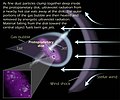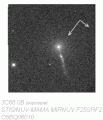Astrophysical jet

An astrophysical jet is an astronomical phenomenon where outflows of ionised matter are emitted as extended beams along the axis of rotation.[1] When this greatly accelerated matter in the beam approaches the speed of light, astrophysical jets become relativistic jets as they show effects from special relativity.
The formation and powering of astrophysical jets are highly complex phenomena that are associated with many types of high-energy astronomical sources. They likely arise from dynamic interactions within accretion disks, whose active processes are commonly connected with compact central objects such as black holes, neutron stars or pulsars. One explanation is that tangled magnetic fields are organised to aim two diametrically opposing beams away from the central source by angles only several degrees wide (c. > 1%).[2] Jets may also be influenced by a general relativity effect known as frame-dragging.[3]
Most of the largest and most active jets are created by
Relativistic jets
Relativistic jets are beams of ionised matter accelerated close to the speed of light. Most have been observationally associated with central black holes of some active galaxies, radio galaxies or quasars, and also by galactic stellar black holes, neutron stars or pulsars. Beam lengths may extend between several thousand,[6] hundreds of thousands[7] or millions of parsecs.[2] Jet velocities when approaching the speed of light show significant effects of the special theory of relativity; for example, relativistic beaming that changes the apparent beam brightness.[8]
Massive central black holes in galaxies have the most powerful jets, but their structure and behaviours are similar to those of smaller galactic
Mechanisms behind the composition of jets remain uncertain,[11] though some studies favour models where jets are composed of an electrically neutral mixture of nuclei, electrons, and positrons, while others are consistent with jets composed of positron–electron plasma.[12][13][14] Trace nuclei swept up in a relativistic positron–electron jet would be expected to have extremely high energy, as these heavier nuclei should attain velocity equal to the positron and electron velocity.
Rotation as possible energy source
Because of the enormous amount of energy needed to launch a relativistic jet, some jets are possibly powered by spinning black holes. However, the frequency of high-energy astrophysical sources with jets suggests combinations of different mechanisms indirectly identified with the energy within the associated accretion disk and X-ray emissions from the generating source. Two early theories have been used to explain how energy can be transferred from a black hole into an astrophysical jet:
- Blandford–Znajek process.[15] This theory explains the extraction of energy from magnetic fields around an accretion disk, which are dragged and twisted by the spin of the black hole. Relativistic material is then feasibly launched by the tightening of the field lines.
- gravitomagnetism.
Relativistic jets from neutron stars

Jets may also be observed from spinning neutron stars. An example is pulsar
Other images
-
Illustration of the dynamics of a proplyd, including a jet
-
Centaurus A in x-rays showing the relativistic jet
-
The M87 jet seen by the Very Large Array in radio frequency (the viewing field is larger and rotated with respect to the above image.)
-
Galaxy NGC 3862, an extragalactic jet of material moving at nearly the speed of light can be seen at the three o'clock position.
-
Some of the jets in HH 24-26, which contains the highest concentration of jets known anywhere in the sky
See also
- Accretion disk
- Bipolar outflow
- Blandford–Znajek process
- Herbig–Haro object
- Penrose process
- CGCG 049-033, elliptical galaxy located 600 million light-years from Earth, known for having the longest galactic jet discovered
- Gamma-ray burst
- Solar jet
References
- ^ Beall, J. H. (2015). "A Review of Astrophysical Jets" (PDF). . Retrieved 19 February 2017.
- ^ . Retrieved 19 February 2017.
- S2CID 139106116.
- .
- ^ "Star sheds via reverse whirlpool". Astronomy.com. 27 December 2007. Retrieved 26 May 2015.
- ^ Biretta, J. (6 Jan 1999). "Hubble Detects Faster-Than-Light Motion in Galaxy M87".
- ^ "Evidence for Ultra-Energetic Particles in Jet from Black Hole". Yale University – Office of Public Affairs. 20 June 2006. Archived from the original on 2008-05-13.
- ^
Semenov, V.; Dyadechkin, S.; Punsly, B. (2004). "Simulations of Jets Driven by Black Hole Rotation". S2CID 1590734.
- doi:10.1086/429663. Retrieved 15 January 2021.
- PMID 36153328.
- ^
Georganopoulos, M.; Kazanas, D.; Perlman, E.; Stecker, F. W. (2005). "Bulk Comptonization of the Cosmic Microwave Background by Extragalactic Jets as a Probe of Their Matter Content". S2CID 39743397.
- ^
Hirotani, K.; Iguchi, S.; Kimura, M.; Wajima, K. (2000). "Pair Plasma Dominance in the Parsec-Scale Relativistic Jet of 3C 345". S2CID 17274015.
- ^ Electron–positron Jets Associated with Quasar 3C 279
- ^ Naeye, R.; Gutro, R. (2008-01-09). "Vast Cloud of Antimatter Traced to Binary Stars". NASA.
- ^ Blandford, R. D.; Znajek, R. L. (1977). "Electromagnetic extraction of energy from Kerr black holes". .
- ^
Penrose, R. (1969). "Gravitational Collapse: The Role of General Relativity". S2CID 117459073.
- ^
PMID 10018300.
- ^
Williams, R. K. (2004). "Collimated Escaping Vortical Polar e−e+Jets Intrinsically Produced by Rotating Black Holes and Penrose Processes". S2CID 1350543.
- ^ "Chandra :: Photo Album :: IGR J11014-6103 :: June 28, 2012".
- ^
Pavan, L.; et al. (2015). "A closer view of the IGR J11014-6103 outflows". Astronomy & Astrophysics. 591: A91. S2CID 59522014.
- ^
Pavan, L.; et al. (2014). "The long helical jet of the Lighthouse nebula, IGR J11014-6103" (PDF). S2CID 118845324. Long helical jet of Lighthouse nebula page 7
- ^
Halpern, J. P.; et al. (2014). "Discovery of X-ray Pulsations from the INTEGRAL Source IGR J11014-6103". S2CID 118637856.
External links
- NASA – Ask an Astrophysicist: Black Hole Bipolar Jets
- SPACE.com – Twisted Physics: How Black Holes Spout Off
- Blandford, Roger; Agol, Eric; Broderick, Avery; Heyl, Jeremy; Koopmans, Leon; Lee, Hee-Won (2001). "Compact Objects and Accretion Disks". arXiv:astro-ph/0107228v1.
- Hubble Video Shows Shock Collision inside Black Hole Jet (Article)






